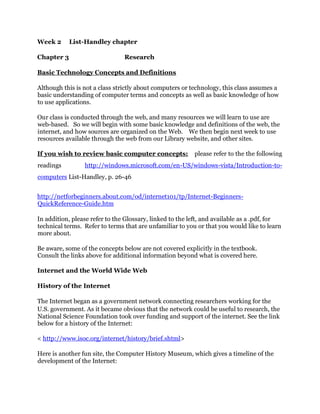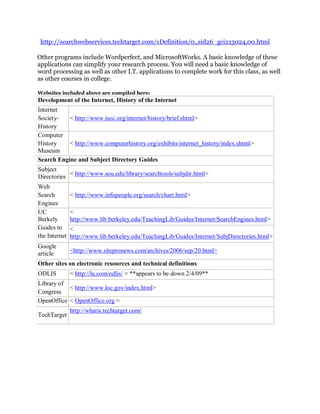This document provides an overview of basic technology concepts and definitions relevant to the class, including the history and structure of the Internet and World Wide Web. It discusses how the Internet began as a government network and is now a global system of interconnected networks. Key points about the Web include that it is part of the Internet and allows users to navigate nonlinearly between pages through hyperlinks. The document also defines common terms like URLs, websites, web browsers, and search engines and directories. It provides examples of different types of digital content and online resources as well as basic software applications.

![< http://www.computerhistory.org/exhibits/internet_history/index.shtml>
Here is a diagram of the Internet, or ARPAnet, as it was called, circa 1983. Not a very
large system in 1983! The nodes show the different universities and government
institutions connected to the network:
* from www.computerhistory.org/exhibits
Today the NSF no longer funds the net [this stopped in 1994]; it is now self-sufficient
and is actually a 'network of networks', with many providers. AOL, Earthlink, and other
commercial ventures provide access to the Internet through their networks to
subscribers.
Although the Web and the Internet seem synonymous, they are actually different. The
Web is a part of the Internet. The Internet includes other technologies:
– Email
– Instant messaging
– File uploading and downloading
Want to see some more interesting facts about the Internet? Take a look at this website [one of
the best for general info about Internet usage]. This site provides some interesting statistics
about Internet use worldwide. It may be no surprise that North America [comprising Canada
and the US] feature the highest rate of Internet use.
http://www.internetworldstats.com/stats.htm](https://image.slidesharecdn.com/week2computerswebandtheinternet-150509173952-lva1-app6891/85/Week-2-computers-web-and-the-internet-2-320.jpg)

![Search engines and directories – which is which?
To find specific things on the web, you must search for them, or use a tool or website
that has pre chosen links for users of the site. Examples of both kinds of tools are search
engines and search directories.
A search engine provides a program which scans web pages in it's system for the
terms that you enter.
A web directory, or subject directory , [you will see these terms interchangeably]
such as Yahoo organizes information more explicitly, providing websites organized by
subject or topic.
Usually a web directory reviews and chooses websites, then organizes them by subject.
Some web [or subject] directories are listed here: <
http://www.sou.edu/library/searchtools/subjdir.html>
Some search engines are listed here :
< http://www.infopeople.org/search/chart.html>
Other Web directories: from p. 43, text:
www.about.com: articles written by human guides on a wide variety of topics.
www.ipl.org Internet Public Library, includes sites reviewed and chosen by librarians.
www.dmoz.org Open Directory Project, 4.5 million sites chosen and compiled by
volunteers
www.vlib.org sites compiled by volunteers who are experts in a wide range of areas
Browsing a web directory can be a good way to sample web sites on a topic. Searching
through a search engine can provide a more systematic focused way to look for a topic.
In each case, the search engine, or the directory, can only access the web sites that are
included in it's index. Even though google.com , considered the most well known of
the general search engines, includes a lot of web sites, it does not provide access to all
web sites.
There are no exact statistics on how many web pages Google indexes, to use them as an
example, but their stated goal is to index 100 billion websites [click here for the story]:
http://www.sitepronews.com/archives/2006/sep/20.html](https://image.slidesharecdn.com/week2computerswebandtheinternet-150509173952-lva1-app6891/85/Week-2-computers-web-and-the-internet-4-320.jpg)
![Even this would not be a full cataloguing of all available and existing web sites; web sites
appear, and disappear, daily, and no one search engine will ever fully be able to index all
web sites.
Other technology features of the Web:
Web Browser: the Web makes information available in a graphical format through a
web browser. A web browser is software programmed to provide links to other sources
on the web.
Hypertext Capability: the web has the capability to 'jump' from one page to another.
You do this by clicking on links, on a page. Here, from the Library of Congress
homepage, we see several links we could follow:
http://www.loc.gov/index.html
This technology allows users to follow pages in a nonlinear fashion. Whichever path we
take is nonlinear; there are several beginning links we could choose, and from there,
more links that we can take through the site in several different ways. We have several
options or ways to move through the site. Other I.T. Applications
Other types of I.T. applications include
word processing: one of the most commonly used I.T. applications. Programs such as
Microsoft Word, Wordperfect, OpenOffice. Can type and manipulate text. The
programs use spell checkers and graphic capabilities.
spreadsheet software: used to calculate numerical information. Programs such as
Microsoft Excel, OpenOffice Calc. Can be used to calculate numbers, create
spreadsheets, and present numerical data into charts and graphs.
presentation programs: incorporate text, graphics, and video into one presentation.
Programs include Microsoft Powerpoint, OpenOffice. Used primarily to present
information to groups, or bring together text, graphics, and other visual materials into
one program.
Microsoft Office is a set of applications that provide a program for all three of these
functions. OpenOffice.org is an open source set of programs that offer the same
capabilities [it's free, with a set of programs similar to Office].
Another term you may see is productivity software; often businesses use this term as
word processing and office software increases productivity for businesses:](https://image.slidesharecdn.com/week2computerswebandtheinternet-150509173952-lva1-app6891/85/Week-2-computers-web-and-the-internet-5-320.jpg)
